Intel Core i9-10850K Review: The Real Intel Flagship
by Dr. Ian Cutress on January 4, 2021 9:00 AM EST- Posted in
- CPUs
- Intel
- Core
- Z490
- 10th Gen Core
- Comet Lake
- LGA1200
- i9-10850K
Gaming Tests: Grand Theft Auto V
The highly anticipated iteration of the Grand Theft Auto franchise hit the shelves on April 14th 2015, with both AMD and NVIDIA to help optimize the title. At this point GTA V is super old, but still super useful as a benchmark – it is a complicated test with many features that modern titles today still struggle with. With rumors of a GTA 6 on the horizon, I hope Rockstar make that benchmark as easy to use as this one is.
GTA doesn’t provide graphical presets, but opens up the options to users and extends the boundaries by pushing even the hardest systems to the limit using Rockstar’s Advanced Game Engine under DirectX 11. Whether the user is flying high in the mountains with long draw distances or dealing with assorted trash in the city, when cranked up to maximum it creates stunning visuals but hard work for both the CPU and the GPU.
We are using the following settings:
- 720p Low, 1440p Low, 4K Low, 1080p Max
The in-game benchmark consists of five scenarios: four short panning shots with varying lighting and weather effects, and a fifth action sequence that lasts around 90 seconds. We use only the final part of the benchmark, which combines a flight scene in a jet followed by an inner city drive-by through several intersections followed by ramming a tanker that explodes, causing other cars to explode as well. This is a mix of distance rendering followed by a detailed near-rendering action sequence, and the title thankfully spits out frame time data. The benchmark can also be called from the command line, making it very easy to use.
There is one funny caveat with GTA. If the CPU is too slow, or has too few cores, the benchmark loads, but it doesn’t have enough time to put items in the correct position. As a result, for example when running our single core Sandy Bridge system, the jet ends up stuck at the middle of an intersection causing a traffic jam. Unfortunately this means the benchmark never ends, but still amusing.
| AnandTech | Low Resolution Low Quality |
Medium Resolution Low Quality |
High Resolution Low Quality |
Medium Resolution Max Quality |
| Average FPS | 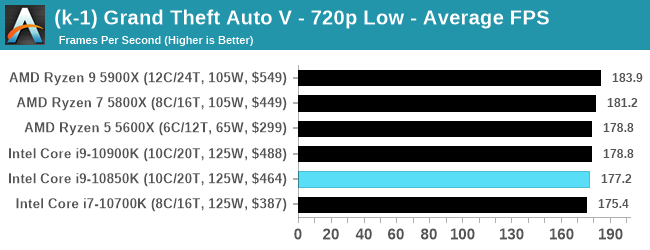 |
 |
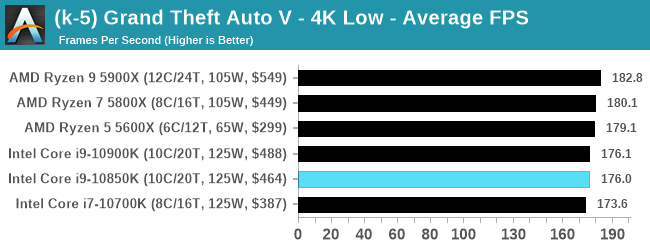 |
 |
| 95th Percentile |  |
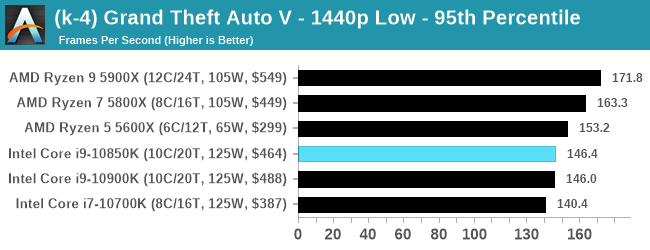 |
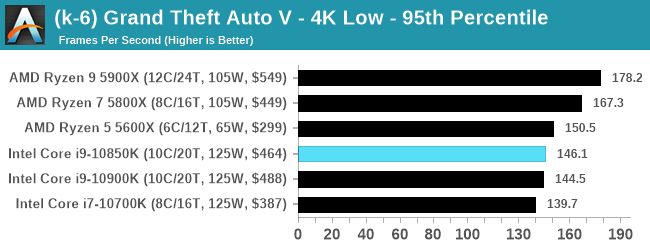 |
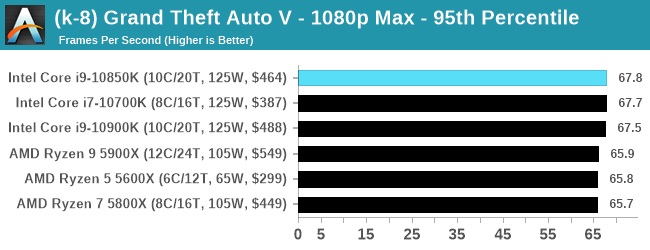 |
All of our benchmark results can also be found in our benchmark engine, Bench.


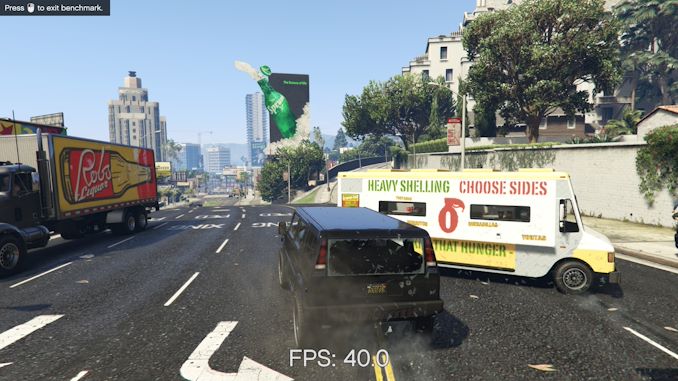









126 Comments
View All Comments
Machinus - Monday, January 4, 2021 - link
Put that piled higher and deeper to use and write an article about how binning affects IC design, before the variability in lithography. Other PhDs read this site tooFreckledTrout - Monday, January 4, 2021 - link
Its the top chart on the the second page. The AIDA stress tests where we are looking at around 260 watts.Machinus - Monday, January 4, 2021 - link
There's a whole article in the chart?j@cko - Monday, January 4, 2021 - link
Nice try Intel. This reminded us of AMD during those FX days when they had nothing good to compete with Intel. Intel's complacency has proven to be quite costly and made some consumers quite bitter toward them. It's gonna take some time to fix that and win back consumer trust and confidence. For example, our company has switched to buying AMD (Ryzen) system since Zen+ and they do not plan on going back to Intel unless AMD goes rogue (complacent with tech and price). Even at my own household, we have built 5 or 6 systems and none of them are Intel.DannyH246 - Monday, January 4, 2021 - link
Yawn. More Intel crap.Desierz - Monday, January 4, 2021 - link
I wonder what Rocket Lake temps will be like..goatfajitas - Monday, January 4, 2021 - link
hotGrayswean - Monday, January 4, 2021 - link
Hence the name.Deicidium369 - Monday, January 4, 2021 - link
same as here if you use the same janky passive HSFzodiacfml - Monday, January 4, 2021 - link
why even work on this? Ryzen 5000 series?